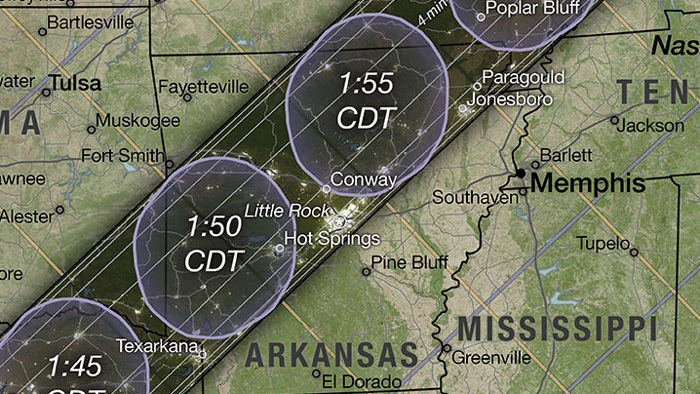A-State Students to Participate in NASA Eclipse Project
JONESBORO – In less than a year, a total solar eclipse will take place on a path through Arkansas. Jonesboro is included in the path of totality.
Two teams from Arkansas State University have been selected to participate in the Nationwide Eclipse Ballooning Project (NEBP), sponsored by NASA. These teams, the only two from the state, will join other high school and college students from across the country.
“For the NEBP we’ll be one of the dozens of teams looking to take atmospheric measurements and livestreaming video of the moon’s shadow from our balloon-borne payloads,” said Dr. Ross Carroll, associate professor of physics in the College of Sciences and Mathematics.
He said the balloons the two teams will launch are around the same size as the National Weather Service’s weather balloons. These, however, are capable of lifting up to 12 pounds of equipment to altitudes over 100,000 feet.
The two teams will be led by Carroll and Mitchell Clay, who works in the Department of Computer Science.
This fall, Clay is teaching a special projects course in computer science focusing on data collection for eclipse ballooning. Carroll said he will guest lecture in the class on the physics behind the mission. They are currently recruiting team members.
According to NASA, this program will allow students to get real-world STEM experience and contribute valuable scientific and engineering data through their projects.
Team member Jacob Rodgers is a senior computer science major from Mountain View.
“This is an exciting opportunity to work on a project with such national significance,” said Rodgers. “It's an honor to play a small part in something this large and I'm grateful for the education and experience that will come along with that.”
The two teams will access the eclipse from different locations.
“My team will launch our balloon from around Russellville so that it’s flying above Mitchell’s team on Petit Jean Mountain while the moon’s shadow passes by. They’ll have a ground station set up to receive our broadcast, then relay that out to a streaming service for NASA’s eclipse website,” said Carroll.
Rodgers said one of the biggest challenges for the launch will be ensuring the data is properly collected from the balloon.
“Since we only have one shot at collecting data from the eclipse, we have to make sure everything works as expected beforehand. There won't be any do-overs if our equipment doesn't work. Additionally, at higher altitudes there are a lot of considerations for our equipment that wouldn't really be a problem on the ground,” said Rodgers.
Carroll said this kind of involvement can inspire students.
“We’re hoping the students get hooked on the NASA-mission-like experiences and move on to interdisciplinary careers,” he added.
Carroll said Montana State University is providing learning materials for the project as well as career development activities for the students.
“I hope to learn a lot from this project, not just about eclipses, but also about the project itself. How the data is collected, how the data is used, all the intricacies involved in a balloon launch, and of course, learning all the questions I didn't even know I had about this sort of project are all things I hope to take away from working on it,” said Rodgers.
While a lot of focus is on the research at this stage, the eclipse will be a once in two-decade experience for area residents.
“We’ll get a little over two minutes of total solar eclipse here on campus, but going closer to the central path west of us will get up to four minutes,” said Carroll.
Students interested in joining one of the teams can contact Carroll at bcarroll@AState.edu or Clay at mclay@AState.edu.
NASA.gov graphic shows the path of the 2024 solar eclipse through Arkansas.

